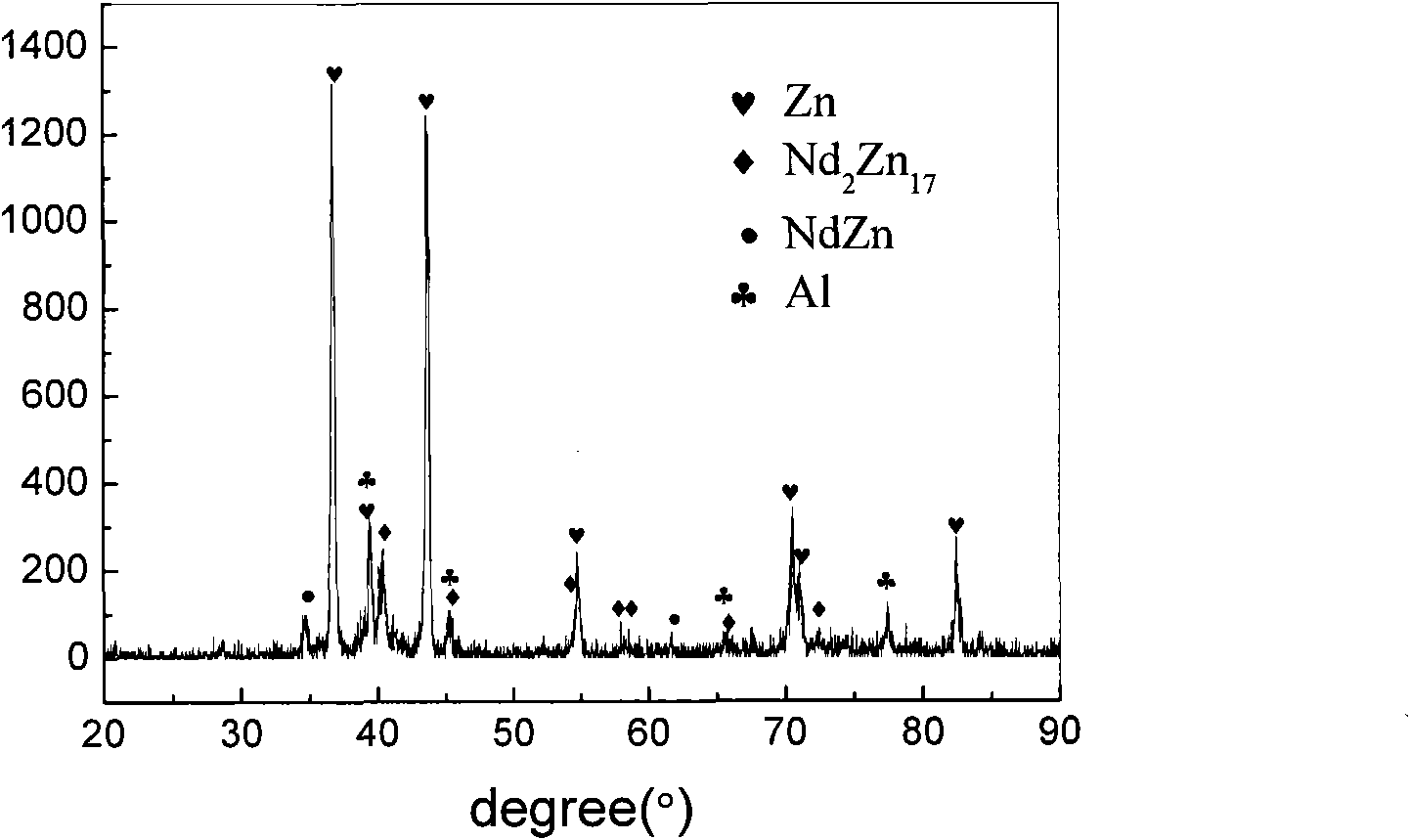Zinc-aluminum-neodymium alloy and fused salt electrolysis preparation method thereof
A molten salt electrolysis and alloy technology, applied in the field of alloys, can solve the problems of easy volatilization and burning loss, large metal loss, high vapor pressure, etc., and achieve the effects of low production cost, shortened production process, and inhibition of volatilization
- Summary
- Abstract
- Description
- Claims
- Application Information
AI Technical Summary
Problems solved by technology
Method used
Image
Examples
Embodiment 1
[0024] Embodiment 1: in the electrolytic furnace, the mass proportion is LiCl: KCl: AlF 3 = 45%: 45%: 10% molten salt system, after heating to 450°C for melting, Nd 2 o 3 and ZnCl 2 Add to the molten salt system after mixing evenly, Nd 2 o 3 and ZnCl 2 The amount added is 2% and 10% of the total weight of the molten salt. The inert metal molybdenum (Mo) is used as the cathode, graphite is used as the anode, the pole distance is 5cm, the electrolysis temperature is 450°C, and the cathode current density is 6.4A / cm 2 , anode current density 0.5A / cm 2 , cell voltage 6.6V, after 120 minutes of electrolysis, heat preservation at 800°C for 2 hours, a liquid Zn-Al-Nd alloy is obtained near the cathode in the molten salt electrolytic cell. After solidification, the contents of zinc, aluminum and neodymium in the alloy are respectively: 94.5%, 5.4%, 0.1%.
Embodiment 2
[0025] Embodiment 2: in the electrolytic furnace, the mass proportion is LiCl: KCl: AlF 3 = 45%: 45%: 10% molten salt system, after heating to 450°C for melting, Nd 2 o 3 and ZnCl 2 Add to the molten salt system after mixing evenly, Nd 2 o 3 and ZnCl 2 The amount added is 2% and 10% of the total weight of the molten salt. The inert metal molybdenum (Mo) is used as the cathode, graphite is used as the anode, the pole distance is 5cm, the electrolysis temperature is 480°C, and the cathode current density is 6.4A / cm 2 , anode current density 0.5A / cm 2 , with a cell voltage of 6.4V, after 120 minutes of electrolysis, at 800°C for 2 hours, a liquid Zn-Al-Nd alloy is obtained near the cathode in the molten salt electrolytic cell. After solidification, the contents of zinc, aluminum, and neodymium in the alloy are respectively: 97.3 %, 2.2%, 0.5%.
Embodiment 3
[0026] Embodiment 3: in the electrolytic furnace, the mass proportion is LiCl: KCl: AlF 3 = 45%: 45%: 10% molten salt system, after heating to 450°C for melting, Nd 2 o 3 and ZnCl 2 (Mass ratio is 1:5) After mixing evenly and pressing into tablets, add once every 0.5 hours in the form of granules, add 4 times in total, each time Nd 2 o 3 , ZnCl 2The addition amount of the mixture is 3% of the total weight of the molten salt. The inert metal molybdenum (Mo) is used as the cathode, graphite is used as the anode, the pole distance is 5cm, the electrolysis temperature is 465°C, and the cathode current density is 6.4A / cm 2 , anode current density 0.5A / cm 2 , with a cell voltage of 6.5V, after 120 minutes of electrolysis, at 800°C for 2 hours, a liquid Zn-Al-Nd alloy is obtained near the cathode in the molten salt electrolytic cell. After solidification, the contents of zinc, aluminum, and neodymium in the alloy are respectively: 93.5%, 4.2%, 1.3%.
PUM
 Login to View More
Login to View More Abstract
Description
Claims
Application Information
 Login to View More
Login to View More - R&D
- Intellectual Property
- Life Sciences
- Materials
- Tech Scout
- Unparalleled Data Quality
- Higher Quality Content
- 60% Fewer Hallucinations
Browse by: Latest US Patents, China's latest patents, Technical Efficacy Thesaurus, Application Domain, Technology Topic, Popular Technical Reports.
© 2025 PatSnap. All rights reserved.Legal|Privacy policy|Modern Slavery Act Transparency Statement|Sitemap|About US| Contact US: help@patsnap.com



